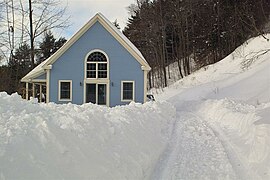Blizzard of 2007
| Category 3 "Major" (RSI: 7.32) | |

Snow cover in Monkton, Vermont
|
|
| Type |
Extratropical cyclone Blizzard Winter storm |
|---|---|
| Formed | February 12, 2007 |
| Dissipated | February 20, 2007 |
| Lowest pressure | 970 mb (28.64 inHg) |
| Maximum snowfall or ice accretion | 48 in (120 cm) Stowe, Vermont |
| Damage | >$50 million (2007 USD) |
| Areas affected | Midwestern and Eastern North America, Gulf States |
| Part of the 2006–07 North American winter | |
The February 2007 North American blizzard was a massive winter storm that affected most of the eastern half of North America, starting on February 12, 2007 and peaking on Valentine's Day, February 14. The storm produced heavy snowfalls across the midwestern United States from Nebraska to Ohio and produced similar conditions across parts of the northeastern United States, and into Canada in Ontario, Quebec and New Brunswick. Significant sleet and freezing rain fell across the southern Ohio Valley and affected portions of the east coast of the United States, including the cities of Boston, Baltimore, Washington, D.C., New York City and Philadelphia.
The southern portion of the storm produced severe thunderstorms with numerous tornadoes reported. One tornado hit a subdivision of New Orleans that was still recovering from the effects of Hurricane Katrina, which hit the region in August 2005. In total, this storm system was responsible for 37 deaths across 13 U.S. states and Canadian provinces of New Brunswick, Ontario and Quebec. The NOAA classified the storm as a Category 3 "Major" storm. The National Weather Service has determined that this storm was one of the three largest snowstorms to hit the inland areas of the northeastern United States since 1940.
In sharp contrast to the mostly mild weather in the first few weeks of winter, the eastern half of the continent was under the influence of cold temperatures. Numerous areas had substantial snowfall deficits before this storm. After several weak Alberta clippers crossed the eastern half of the continent and brought occasional light snowfalls, a large dip in the Northern branch of the jet stream favored a more active pattern, which, as it connected with the southern branch, led to the development of the storm.
...
Wikipedia
